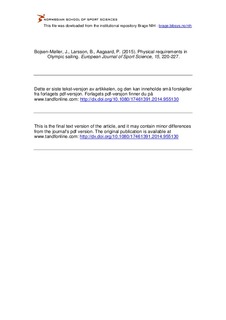| dc.contributor.author | Bojsen-Møller, Jens | |
| dc.date.accessioned | 2016-04-06T09:05:13Z | |
| dc.date.available | 2016-04-06T09:05:13Z | |
| dc.date.issued | 2014-09-18 | |
| dc.identifier.citation | European Journal of Sport Science. 2015, 15, 220-227. | nb_NO |
| dc.identifier.uri | http://hdl.handle.net/11250/2384222 | |
| dc.description | I Brage finner du siste tekst-versjon av artikkelen, og den kan inneholde ubetydelige forskjeller fra forlagets pdf-versjon. Forlagets pdf-versjon finner du på www.tandfonline.com: http://dx.doi.org/10.1080/17461391.2014.955130 / In Brage you'll find the final text version of the article, and it may contain insignificant differences from the journal's pdf version. The definitive version is available at www.tandfonline.com: http://dx.doi.org/10.1080/17461391.2014.955130 | nb_NO |
| dc.description.abstract | Physical fitness and muscular strength are important performance parameters in Olympic sailing although their relative importance changes between classes. The Olympic format consists of eight yacht types combined into 10 so-called events with total 15 sailors (male and female) in a complete national Olympic delegation. The yachts have different requirements with respect to handling, and moreover, each sailor plays a specific role when sailing. Therefore physical demands remain heterogeneous for Olympic sailors. Previous studies have mainly examined sailors where ‘hiking’ (the task of leaning over the side of the yacht to increase righting moment) is the primary requirement. Other than the ability to sustain prolonged quasi-isometric contractions, hiking seems to require significant maximal muscle strength especially in knee extensors, hip flexors and abdominal and lower back muscles. Another group of studies has investigated boardsailing and provided evidence to show that windsurfing requires very high aerobic and anaerobic capacity. Although data exist on other types of sailors, the information is limited, and moreover the profile of the Olympic events has changed markedly over the last few years to involve more agile, fast and spectacular yachts. The change of events in Olympic sailing has likely added to physical requirements; however, data on sailors in the modern-type yachts are scarce. The present paper describes the recent developments in Olympic sailing with respect to yacht types, and reviews the existing knowledge on physical requirements in modern Olympic sailing. Finally, recommendations for future research in sailing are given. | nb_NO |
| dc.language.iso | eng | nb_NO |
| dc.publisher | Taylor & Francis | nb_NO |
| dc.subject | yachting | nb_NO |
| dc.subject | hiking | nb_NO |
| dc.subject | endurance | nb_NO |
| dc.subject | strength | nb_NO |
| dc.subject | physical requirements | nb_NO |
| dc.title | Physical requirements in Olympic sailing | nb_NO |
| dc.type | Journal article | nb_NO |
| dc.type | Peer reviewed | nb_NO |
| dc.subject.nsi | VDP::Social science: 200 | nb_NO |
| dc.subject.nsi | VDP::Social science: 200::Social science in sports: 330 | nb_NO |
| dc.subject.nsi | VDP::Social science: 200::Social science in sports: 330::Other subjects within physical education: 339 | nb_NO |
| dc.source.journal | European Journal of Sport Science | nb_NO |
| dc.identifier.doi | 10.1080/17461391.2014.955130 | |
| dc.description.localcode | Seksjon for fysisk prestasjonsevne / Department of Physical Performance | nb_NO |
